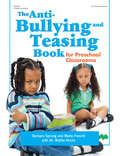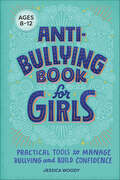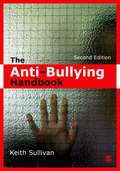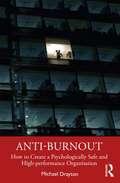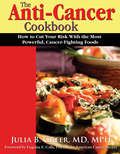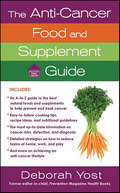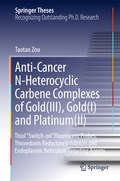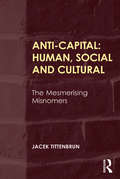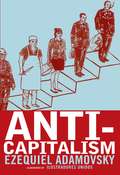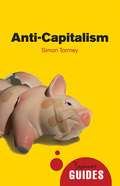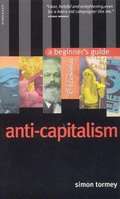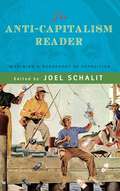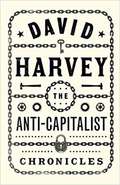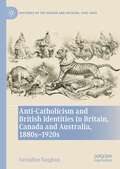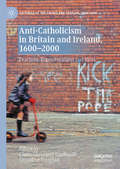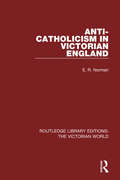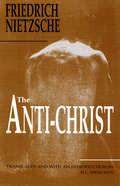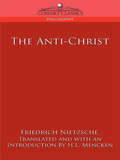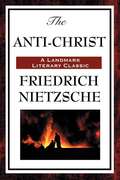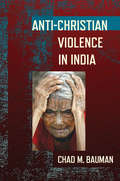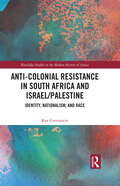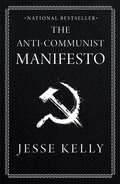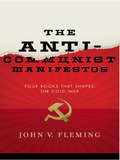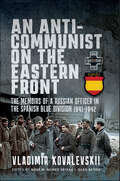- Table View
- List View
The Anti-Bullying and Teasing Book: For Preschool Classrooms
by Merle Froschl Dr Blythe Hinitz Barbara SprungIn preschool, children encounter their first experiences in forming and joining social groups outside their family. It is natural for them to experiment with social interactions while learning about their world. In this guide, teasing and bullying are addressed as a continuum of intentionally hurtful behavior, from making fun of someone to repetitive physical abuse. Creating a caring environment at the beginning of school reduces the need for children to assert themselves through negative behavior such as teasing and bullying. With The Anti-Bullying and Teasing Book, teachers of young children can address this behavior before it develops. Special features of this book: Information on family-school partnerships to engage families in the development of a caring community and to reinforce teachings about empathy and mutual respect. Techniques to teach children how to think about and manage their feelings in a safe and appropriate way. Tips for teaching children how to act appropriately as a "bystander." Children who stand by while a friend is being teased and bullied may be uneasy or even scared that they might be next. They feel powerless and learn negative ways to interact with others. Teachers have the opportunity to work with bystanders, helping them to develop the confidence to stand up for a friend. As a result, children will become more able to stand up for themselves and not tolerate teasing and bullying behavior. The Anti-Bullying and Teasing Book creates an environment that reinforces the positive messages essential to children's sense of safety and well-being. Some such messages are quoted from "Hurt-Free Schools" by M. Christine Mattise: If you are hurt on the playground, someone will come to see if you are all right. If you are alone, you are welcome to join in a game. If you are being teased, other children will come and tell the teaser to stop. If you need help, ask an adult. When certain social milestones and goals are achieved, children can easily live and work within their world. According to the National Association for the Education of Young Children (NAEYC) Code of Ethical Conduct, these goals can be stated in terms of "democratic life skills," which include the ability to: see one's self as a worthy individual and a capable member of the group. express strong emotions in non-hurting ways. solve problems ethically and intelligently. be understanding of the feeling and viewpoints of others. work cooperatively in groups, with acceptance of the human differences among members. Teachers have a major influence on how children view themselves within the larger world. Children mimic teachers' language and interactions. By creating a climate of mutual respect, teachers can help children learn to develop empathy and treat others fairly and kindly, and to stand up for themselves and their friends in safe and developmentally appropriate ways. The Anti-Bullying and Teasing Book will help teachers create a school environment in which all children feel comfortable, safe, and welcome.
Anti-Bullying Book for Girls: Practical Tools to Manage Bullying and Build Confidence
by Jessica WoodyIn the Anti-Bullying Book for Girls, girls ages 8-12 will find supportive advice that addresses the unique challenges of girl-on-girl bullying and shows them how to boost their confidence, deal with bullying in the moment, and be more empathetic toward others.One of the toughest issues girls face is bullying, so stand up to it with this interactive guide! This standout among bullying books will help girls find their voice and put a stop to bullying, whether it's happening to them or to their friends. In addition to teaching kids to be kind, this hands-on guide can help girls:Better understand bullying—Get a breakdown of what bullying is, why it happens, the difference between bullying and teasing, and how girl bullying often looks different from boy bullying.Express themselves creatively—Girls will discover plenty of space to write and reflect on their experiences, plus drawing prompts, quizzes, affirmations, and more to help them battle bullying.Build healthy friendships—Empower girls with the tools to move on from a toxic friendship, disagree with others respectfully, and form great lifelong friendships.Give girls the tools and support they need to stop bullying in its tracks with Anti-Bullying Book for Girls!
The Anti-Bullying Handbook
by Keith SullivanWriting from a constructivist and social-ecological perspective, Sullivan (education, National U. of Ireland, Galway) offers a resource for teachers, administrators, parents, school and community agencies, as well as teacher educators to combat school bullying. The handbook summarizes current knowledge; guides schools in the development, implementation, and evaluation of effective anti-bullying philosophies; recommends anti-bullying programs; and supports a culture of problem solving that draws on research and experience. He discusses definitions, types of bullying, approaches to implementing programs, preventative strategies, and specific programs. This edition incorporates new and updated information. Annotation ©2011 Book News, Inc. , Portland, OR (booknews. com)
Anti-burnout: How to Create a Psychologically Safe and High-performance Organisation
by Michael DraytonBurnout results in people feeling exhausted, cynical, detached and hopeless – even depressed and anxious. This book looks at burnout from an individual, group and organisational perspective. It uses anecdotes from the author’s life; and examples from literature, poetry and art to bring the subject to life. Based on the latest scientific thinking on burnout and evidence-based ideas, this practical, easy read book gives leaders the knowledge they need to create a psychologically healthy and high performance culture at work. After reading this book, you will understand more about burnout than 90 per cent of the population. You will know what to do to prevent burnout in other people and in yourself. Anti-burnout is an academically rigorous book, written in a friendly, engaging, conversational style. It contains lots of anecdotes, examples from the arts and stories that illustrate and bring to life the practical advice on preventing burnout. Anti-burnout will answer these questions: What exactly is burnout? How does burnout affect individuals, teams and organisations? What causes burnout? How can I understand and support people with burnout? How can I prevent myself from burning out? What are the obstacles to preventing burnout? How does remote working affect burnout? What can I do to create a workplace culture that prevents burnout? This book is helpful because it relates the scientific literature on burnout to real life. Anti-burnout looks at the individual factors in burnout, including personality and mental health. It also looks at how the dynamics of teams and how work is organised relate to burnout. Finally, the book investigates organisational culture, leadership and burnout. This book is essential reading for leaders and managers who want to minimise burnout in people in their organisation. It will also be essential reading for anyone with an interest in mental well-being at work such as occupational health practitioners, researchers and human resource professionals.
The Anti-Cancer Cookbook
by Julia B GreerEverything you need to know about anti-cancer foods into one handy book. Explains what cancer is and how antioxidants work to prevent pre-cancerous mutations in your body's cells, and then describes in detail which foods have been scientifically shown to help prevent which types of cancer.
The Anti-Cancer Food and Supplement Guide (Healthy Home Library)
by Deborah YostThe Anti-Cancer Food and Supplement Guide: How to Protect Yourself and Enhance Your Health provides the most comprehensive, up-to-date information you need to help prevent and treat cancer—naturally and nutritionally.• A-to-Z listings of anti-cancer foods, vitamins, and supplements• How to remove toxins in your home and workplace to create a "risk-free" environment• How to incorporate healthier foods and supplements into your daily diet• Delicious, family-friendly recipes, meal plans, and nutritional guidelines• Life-saving advice on genetic risk factors, early detection, diagnosis, and treatment• The latest medical studies supporting the importance of certain foods and supplements in fighting cancer
Anti-Cancer N-Heterocyclic Carbene Complexes of Gold: Thiol “Switch-on” Fluorescent Probes, Thioredoxin Reductase Inhibitors and Endoplasmic Reticulum Targeting Agents (Springer Theses)
by Taotao ZouThis thesis focuses on the development of gold- and non-classical platinum-based anti-cancer agents that display distinctively different anti-cancer mechanisms compared to the commonly used cisplatin. These metal complexes contain N-heterocyclic carbene (NHC) ligands which are able to form strong M-C(NHC) bonds, conferring high stability and favorable lipophilicity, reactivity and binding specificity of metal complexes on biomolecules. The author demonstrates significant advances made in anti-cancer gold(III), gold(I) and platinum(II) complexes. Detailed chemical synthesis, in vitro and/or in vivo anti-cancer activities are clearly presented including: (i) a class of Au(III) complexes containing a highly fluorescent N^N^N ligand and NHC ligand that simultaneously act as fluorescent thiol "switch-on" probes and anti-cancer agents; (ii) a dinuclear gold(I) complex with a mixed diphosphine and bis(NHC) ligand displaying favorable stability and showing significant inhibition of tumor growth in two independent mice models with no observable side effects; and (iii) a panel of stable luminescent cyclometalated platinum(II) complexes exhibiting high specificity to localize to the endoplasmic reticulum (ER) domain, inducing ER stress and cell apoptosis. These works highlight the clinical potential that gold and platinum complexes offer for cancer treatment.
Anti-Capital: The Mesmerising Misnomers
by Jacek TittenbrunThe notion of capital has enjoyed a rich career in the social sciences, its use across a range of subjects and in diverse academic and professional contexts having served to establish its conceptual status as 'given'. With particular attention to human and social capital - including cultural capital - this book traces the roots of this theoretical and conceptual trend to economics, revealing the proliferation of various forms of capital to be based upon an encroachment of the conceptual apparatus of economics into other social sciences. Offering an in-depth, critical analysis of the concepts of human and social capital, as well as their surrounding theories, Anti-Capital: Human, Social and Cultural proposes an alternative theoretical framework, whilst better explaining the realities that they mask in economic terms. A rigorous exploration of the most popular forms of 'capital' in the contemporary social sciences, this book will be of interest to scholars and students of sociology, political and social theory, demography and economics.
Anti-Capitalism
by Ezequiel Adamovsky Marie TrigonaIn Anti-Capitalism, activist and scholar Ezequiel Adamovsky tells the story of the long-standing effort to build a better world, one without an abusive system at its heart. Backed up by arresting, lucid images from the radical artist group United Illustrators, Adamovsky details the struggle against rising corporate power, as that struggle unfolds in the halls of academia, in the pages of radical newspapers, and in the jungles and the streets. From Marx through the Battle of Seattle and beyond, Adamovsky traces the beliefs and politics of the major figures in the anticapitalist tradition and explores modern experiments in building different ways of living, in the process providing an indispensible primer for anyone interested in finding alternatives to the so-called "best system we have"--and anyone interested in joining the fight.
Anti-Capitalism: A Beginner's Guide (Beginner's Guides)
by Simon TormeyThe puncture of the great banking bubble and the dash to austerity has breathed new life into protest movements across the globe and brought anti-capitalist values to the forefront as never before. But what does it mean to be anti-capitalist? And where is anti-capitalism going - if anywhere? Global civil society expert Simon Tormey explores these questions, and more, in this thought-provoking book.Unlike other, ideologically-narrow introductions, Tormey introduces us to all the eclectic groups - anarchists, Marxists, autonomists, environmentalists - and thought that make up the anti-capitalist movement. Providing global and historical context, he takes us from the 1994 Zapatista insurrection through the 1999 Seattle protests right up to Occupy Wall Street, the Indignados of Spain and the current Greek uprisings. Going beyond a mere descriptive take, Tormey weighs up a range of possibilities for bringing about alternatives to the corporate domination of our planet. This is a fascinating and bold exploration of how to understand the world - and how to change it.
Anti-Capitalism: A Beginner's Guide
by Simon TormeySpecifically, the book tackles the questions: Who exactly are the anti-capitalists and what do they want? Simon Tormey examines the ideas of the various components that make up the movement: the anarchists and Marxists, the greens and environmentalists, the anti-corporate activists and utonomists, among many others. He looks in detail at how the movement operates its reliance on a unique combination of word-of-mouth, the internet, and communications technology.
The Anti-Capitalism Reader: Imagining A Geography Of Opposition
by Joel SchalitFrom Seattle and Genoa back to Marx and Gramsci, the left is back, going global to fight the virus of modern greed. A refreshingly non-doctrinaire collection of writings on the theory, practice, and history of anti-capitalist politics from the most well-versed activists and scholars in the movement. Since the demonstrations against the World Trade Organization in Seattle two years ago, the world has witnessed the emergence of a brand new left. Largely focusing on such issues as third-world debt reduction and the emergence of a decidedly undemocratic transnational political order, this new progressivism is a rich and complex phenomenon which demands careful analysis to understand its ascendance ten years after the Cold War—in a time of supposed affluence and ongoing celebration of capitalism’s triumph over the Soviet Union. Aimed squarely at activists and academics, as well those interested in educating themselves about the anti-market tenor of the new left, this is a comprehensive and accessible introduction to anti-capitalist politics and cultures. Contributors include SF Bay Guardian Culture editor and high-tech critic Annalee Newitz, Wall Street author and Left Business Observer editor Doug Henwood, journalist and social critic Liza Featherstone, as well as interviews with influential thinkers such as Slavoj Zizek, Frederic Jameson, Susan George, and Antonio Negri (co-author of Empire). Among the topics explored are the presence of anti-capitalist movements in everyday life, the history of anti-capitalism, strategies of anti-capitalist resistance, regionalism and anti-capitalism, and anti-capitalism and intellectual property. Includes a brief selection of some of the most historically important criticisms of the free market from the likes of Marx, Gramsci, and other Marxist, anarchist, and Situationist thinkers. Editor Joel Schalit is the author of Jerusalem Calling and editor of both Punk Planet magazine and webzine Bad Subjects: Political Education for Everyday Life. He is a regular contributor to the SF Bay Guardian. Contributors: Megan Shaw Rick Prelinger Jason Meyers Annalee Newitz Scott Schaffer Doug Henwood Liza Featherstone Interviews: Slavoj Zizek Frederic Jameson Susan George
The Anti-Capitalist Chronicles
by David HarveyAmidst waves of economic crises, health crises, class struggle and neo-fascist reaction, few possess the clarity and foresight of world-renowned theorist, David Harvey. Since the publication of his bestselling A Brief History of Neoliberalism, Harvey has been tracking the evolution of the capitalist system as well as tides of radical opposition rising against it. In The Anti-Capitalist Chronicles, Harvey introduces new ways of understanding the crisis of global capitalism and the struggles for a better world. While accounting for violence and disaster, Harvey also chronicles hope and possibility. By way of conversations about neoliberalism, capitalism, globalization, the environment, technology, social movements and crises like COVID-19, he outlines, with characteristic brilliance, how socialist alternatives are being imagined under very difficult circumstances. In understanding the economic, political and social dimensions of the crisis, Harvey’s analysis in The Anti-Capitalist Chronicles will be of strategic importance to anyone wanting to both understand and change the world.
Anti-Catholicism and British Identities in Britain, Canada and Australia, 1880s-1920s (Histories of the Sacred and Secular, 1700–2000)
by Geraldine VaughanRecent debates about the definition of national identities in Britain, along with discussions on the secularisation of Western societies, have brought to light the importance of a historical approach to the notion of Britishness and religion. This book explores anti-Catholicism in Britain and its Dominions, and forms part of a notable revival over the last decade in the critical historical analysis of anti-Catholicism. It employs transnational and comparative historical approaches throughout, thanks to the exploration of relevant original sources both in the United Kingdom and in Australia and Canada, several of them untapped by other scholars. It applies a 'four nations' approach to British history, thus avoiding an Anglocentric viewpoint.
Anti-Catholicism in Britain and Ireland, 1600–2000: Practices, Representations and Ideas (Histories of the Sacred and Secular, 1700–2000)
by Claire Gheeraert-Graffeuille Geraldine VaughanThis edited collection brings together varying angles and approaches to tackle the multi-dimensional issue of anti-Catholicism since the Protestant Reformation in Britain and Ireland. It is of course difficult to infer from such geographically and historically diverse studies one single contention, but what the book as a whole suggests is that there can be no teleological narration of anti-Catholicism – its manifestations were episodic, more or less rooted in common worldviews, and its history does not end today.
Anti-Catholicism in Victorian England (Routledge Library Editions: The Victorian World Ser. #36)
by E. NormanFirst published in 1968, this book provides an introduction to the subject of anti-Catholicism in Victorian England and a selection of illustrative documents. It demonstrates that Victorian ‘No Popery’ agitations were in fact almost the last expressions of a long English tradition of anti-Catholic intolerance and, in reality, the legal and socia
The Anti-Christ
by H. L. Mencken Friedrich NietzscheThis is Nietzsche's last book and a fitting capstone to his career. It's succinct, biting, and encapsulates the criticisms of Christianity found in his other works. This edition contains an 8,000-word introduction by its translator, the famous iconoclastic writer H. L. Mencken.
The Anti-Christ
by Friedrich Nietzsche"The Christian concept of a god-the god as the patron of the sick, the god as a spinner of cobwebs, the god as a spirit-is one of the most corrupt concepts that has ever been set up in the world... In him nothingness is deified, and the will to nothingness is made holy." See Sharp Press; Tuscon, AZ -from The Anti-Christ. He's one of the most debated thinkers of the 19th century: Nietzsche and his works have been by turns vilified, lauded, and subjected to numerous contradictory interpretations, and yet he remains a figure of profound import, and his works a necessary component of a well-rounded education. The Anti-Christ, first published in German in 1895, is absolutely vital to any meaningful understanding of Nietzsche the man and Nietzsche the philosopher. An insightful and entertaining indictment of Christianity, it has enraged and inspired generations of readers, and this 1920 translation, by H. L. Mencken, considered the best available, is almost as controversial as the work itself, highlighting the darkest side of Mencken's cynicism. Also available from Cosimo Classics: Nietzsche's The Use and Abuse of History.
The Anti-Christ
by Friedrich NietzscheHere is Friedrich Nietzsche's great masterpiece The Anti-Christ, wherein Nietzsche attacks Christianity as a blight on humanity. This classic is essential reading for anyone wishing to understand Nietzsche and his place within the history of philosophy. "We should not deck out and embellish Christianity: it has waged a war to the death against this higher type of man, it has put all the deepest instincts of this type under its ban, it has developed its concept of evil, of the Evil One himself, out of these instincts-the strong man as the typical reprobate, the 'outcast among men.' Christianity has taken the part of all the weak, the low, the botched; it has made an ideal out of antagonism to all the self-preservative instincts of sound life; it has corrupted even the faculties of those natures that are intellectually most vigorous, by representing the highest intellectual values as sinful, as misleading, as full of temptation. The most lamentable example: the corruption of Pascal, who believed that his intellect had been destroyed by original sin, whereas it was actually destroyed by Christianity!" -Friedrich Nietzsche
The Anti-Christ, Ecce Homo, Twilight of the Idols: And Other Writings
by Friedrich NietzscheNietzsche's late works are brilliant and uncompromising, and stand as monuments to his lucidity, rigor, and style. This volume combines, for the first time in English, five of these works: The Antichrist, Ecce Homo, Twilight of the Idols, Nietzsche contra Wagner, and The Case of Wagner. Nietzsche takes on some of his greatest adversaries in these works: traditional religion, contemporary culture, and above all, his one-time hero, Richard Wagner. His writing is simultaneously critical and creative, revealing his alternative philosophical vision, which, after more than a hundred years, still retains its audacious originality.
Anti-Christian Violence in India (Religion and Conflict)
by Chad M. BaumanDoes religion cause violent conflict, asks Chad M. Bauman, and if so, does it cause conflict more than other social identities? Through an extended history of Christian-Hindu relations, with particular attention to the 2007–2008 riots in Kandhamal, Odisha, Anti-Christian Violence in India examines religious violence and how it pertains to broader aspects of humanity. Is "religious" conflict sui generis, or is it merely one species of intergroup conflict? Why and how might violence become an attractive option for religious actors? What explains the increase in religious violence over the last twenty to thirty years?Integrating theories of anti-Christian violence focused on politics, economics, and proselytization, Anti-Christian Violence in India additionally weaves in recent theory about globalization and, in particular, the forms of resistance against Western secular modernity that globalization periodically helps to provoke. With such theories in mind, Bauman explores the nature of anti-Christian violence in India, contending that resistance to secular modernities is, in fact, an important but often overlooked reason behind Hindu attacks on Christians. Intensifying the widespread Hindu tendency to think of religion in ethnic rather than universal terms, the ideology of Hindutva, or "Hinduness," explicitly rejects both the secular privatization of religion and the separability of religions from the communities that incubate them. And so, with provocative and original analysis, Bauman questions whether anti-Christian violence in contemporary India is really about religion, in the narrowest sense, or rather a manifestation of broader concerns among some Hindus about the Western sociopolitical order with which they associate global Christianity.
Anti-Colonial Resistance in South Africa and Israel/Palestine: Identity, Nationalism, and Race (Routledge Studies in the Modern History of Africa)
by Ran GreensteinThis book provides a comparative historical study of the rise and evolution of anti-colonial movements in South Africa and Israel/Palestine. It focuses on the ways in which major political movements and activists conceptualised their positions vis-a-vis historical processes of colonial settlement and indigenous resistance over the last century. Drawing on a range of primary sources, the author engages with theoretical debates involving key actors operating in their own time and space. Using a comparative framework, the book illustrates common and divergent patterns of political and ideological contestations and focuses on the relevance of debates about race and class, state and power, ethnicity and nationalism. Particular attention is given to South Africa and Israel/Palestine’s links to global campaigns to undermine foreign domination and internal oppression, tensions between the quests for national liberation and equality of rights, the role of dissidents from within the ranks of settler communities, and the various attempts to consolidate indigenous resistance internally while forging alliances with other social and political forces on the outside. This book will be of interest to scholars in the fields of African History, Middle East History, and African Studies, and to social justice and solidarity activists globally.
The Anti-Communist Manifesto
by Jesse KellyA rallying cry striking at the roots of today&’s major issues, Jesse Kelly uses his trademark bombast, intelligence, and humor to take down the most dangerous philosophy in history and address its resurgence in America. The Anti-Communist Manifesto is for anyone who feels alienated by political and popular culture in the United States and recognizes the danger of communism as it threatens to rip apart America&’s social fabric. Discover a fresh look at the daily assault on our freedoms from the insidious communist movement in this country. More than a political statement, this book is an insightful drive through history, philosophy, and current events with one of the most entertaining and fearless conservatives in America at the wheel. From weaponizing race, sex, and gender to hijacking our schools, communism threatens to destroy our cherished American way of life. Featuring practical tools and tactics to not only identify communists but also defend the United States from this malicious enemy, The Anti-Communist Manifesto is an instructive guide for all patriots.
The Anti-Communist Manifestos: Four Books That Shaped the Cold War
by John V. FlemingThe books altered the course of history; the lives behind them have the dark fascination of fiction. The subject of The Anti-Communist Manifestos is four influential books that informed the great political struggle known as the Cold War: Darkness at Noon (1940), by Arthur Koestler, a Hungarian journalist and polymath intellectual; Out of the Night (1941), by Jan Valtin, a German sailor and labor agitator; I Chose Freedom (1946), by Victor Kravchenko, a Soviet engineer; and Witness (1952), by Whittaker Chambers, an American journalist. The authors were ex-Communist Party members whose bitter disillusionment led them to turn on their former allegiance in literary fury.Koestler was a rapist, Valtin a thug. Kravchenko, though not a spy, was forced to live like one in America. Chambers was a prophet without honor in his own land. Three of the four had been underground espionage agents of the Comintern. All contemplated suicide, and two of them achieved it. John V. Fleming's humane and ironic narrative of these grim lives reveals that words were the true driving force behind the Cold War.
An Anti-Communist on the Eastern Front: The Memoirs of a Russian Officer in the Spanish Blue Division 1941-1942
by Vladimir KovalevskiVladimir Kovalevskii’s memoirs record in graphic detail a remarkable military career. As a soldier, a committed anti-communist and Russian patriot he saw from the inside a series of conflicts that ravaged Europe in the first half of the twentieth century. In the First World War he fought the Germans, as a White Russian he opposed the Bolsheviks. He joined the French Foreign Legion and served in Africa before fighting for Franco in the Spanish Civil War and for Hitler in the Spanish Blue Division on the Eastern Front in the Second World War. His memoirs give a vivid insight into the armies he fought with and the causes he fought for – and they show how eventually the mental toll became so great that he was devoured by his own contradictions and the contradictions of his times. His experiences on the Eastern Front during the Second World War were shocking. He hoped the German campaign in the Soviet Union would liberate the Russian people, but after witnessing the grim suffering inflicted on the civilian population by a brutal occupying army he was deeply disillusioned and tormented by a sense of guilt. In the late 1940s, in order to make sense of his life as a soldier and to document the extraordinary sights he’d seen, he wrote these memoirs in Russian. They were buried in an archive for over seventy years, but they have now been edited, annotated and translated for this first English edition.
